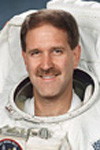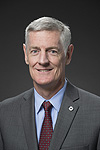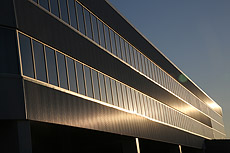|
|
Hall of Fame astronaut gives colloquium today at 4 p.m.
 |
|
John Grunsfeld
|
It isn't often you get the chance to be in the same room with an astronaut. Even rarer is the opportunity to hear from an astronaut of John Grunsfeld's caliber.
Today at 4 p.m., Grunsfeld will give a Fermilab Colloquium in One West. A Chicago native and an astrophysicist, Grunsfeld is a veteran of five Space Shuttle flights and has clocked more than 50 hours spacewalking. He visited the Hubble Space Telescope on three of his space shuttle missions and serviced and upgraded the HST. He served as NASA's chief scientist in 2003 and 2004, as deputy director of the Space Telescope Institute in Maryland from 2009 to 2011, and since January 2012 has been serving as associate administrator of NASA's Science Mission Directorate.
The talk is free and open to the public.
|
New discovery? Or just another bump?
 |
For physicists, seeing is not always believing.
Image: Sandbox Studio with Ana Kova |
In the 1960s physicists at the University of California, Berkeley, saw evidence of new, unexpected particles popping up in data from their bubble chamber experiments.
But before throwing a party, the scientists did another experiment. They repeated their analysis, but instead of using the real data from the bubble chamber, they used fake data generated by a computer program, which assumed there were no new particles.
The scientists performed a statistical analysis on both sets of data, printed the histograms, pinned them to the wall of the physics lounge, and asked visitors to identify which plots showed the new particles and which plots were fakes.
No one could tell the difference. The fake plots had just as many impressive deviations from the theoretical predictions as the real plots.
Eventually, the scientists determined that some of the unexpected bumps in the real data were the fingerprints of new composite particles. But the bumps in the fake data remained the result of random statistical fluctuations.
So how do scientists differentiate between random statistical fluctuations and real discoveries?
Just like a baseball analyst can't judge if a rookie is the next Babe Ruth after nine innings of play, physicists won't claim a discovery until they know that their little bump-on-a-graph is the real deal.
After the histogram "social experiment" at Berkeley, scientists developed a one-size-fits-all rule to separate the "Hall of Fame" discoveries from the "few good games" anomalies: the five-sigma threshold.
Read more
—Sarah Charley
|
Nobel Prize for key discoveries about subatomic particles
From The New York Times, Oct. 6, 2015
STOCKHOLM — Two scientists won the Nobel Prize in physics Tuesday for key discoveries about a cosmic particle that whizzes through space at nearly the speed of light, passing easily through Earth and even your body.
Takaaki Kajita of Japan and Arthur McDonald of Canada were honored for showing that these tiny particles, called neutrinos, have mass. That's the quality we typically experience as weight.
Read more
|
Physicists' Nobel Prize for neutrino research a big boost for counterparts at Fermilab
From CBS Chicago, Oct. 6, 2015
CHICAGO (CBS) — Scientists at Fermilab on Tuesday were celebrating the Nobel Prize awarded to two fellow physicists for their work on neutrinos, subatomic particles which are notoriously difficult to study.
Fermilab scientist Debbie Harris said the Nobel Prize awarded to Japanese physicist Takaaki Kajita and Canadian physicist Arthur B. McDonald helps validate the work she and others are doing on neutrinos at the Fermi National Accelerator Laboratory near Batavia.
"Oh, it's great. It's a great shot in the arm," she said.
Read more
|
|
New LBNF organization
 |
|
Chris Mossey
|
In May our director, Nigel Lockyer, announced his intent to form an organization to support the U.S. flagship neutrino program based at Fermilab. This program includes the Long-Baseline Neutrino Facility (LBNF), which will provide the support infrastructure, and the high-intensity neutrino beam necessary to enable the Deep Underground Neutrino Experiment (DUNE) to proceed.
LBNF will require unique facilities to support DUNE's far site detectors at the Sanford Underground Research Laboratory, in Lead, South Dakota, as well as here at Fermilab, the so-called "near site." In recognition of this, the LBNF organization includes two new divisions — Far-Site Facilities and Near-Site Facilities — as well as a project office, all led by the LBNF project director. Although this organization has been on the Fermilab organization chart for some time, as of Monday, personnel actions to stand up the new organization, including transfers between divisions and changes to FermiWorks and Kronos, have been implemented. A detailed LBNF project organization chart indicates the reporting structure for this new line organization.
This change represents another significant step in Fermilab's accelerating progress to serve as the host for the first international megascience project sponsored by DOE in the United States.
This new organization will allow us to continue to focus on our next major milestone — the upcoming DOE CD-3a review — scheduled for the first week of December at the Sanford Lab in South Dakota.
It is an exciting time, and we intend to keep you updated on the progress of these projects. For more information, please refer to the LBNF and DUNE websites. On behalf of the LBNF team, thank you for your strong support of this flagship initiative!
|
Food trucks at Fermilab tomorrow, 11 a.m.-2 p.m.
Fermilab will pilot food trucks at the lab the next two Thursdays. Tomorrow, Oct. 8, two trucks will serve lunch from 11 a.m. until 2 p.m. Toasty Cheese will be located in the parking lot east of Wilson Hall, and Bacci Pizza will be located in the parking lot just west of Industrial Building 1, across the street from IARC. Picnic tables will be set up near each of the trucks if you'd like to dine outdoors.
Next Thursday, Oct. 15, the trucks will swap locations so that you'll be able to get a gourmet grilled cheese sandwich by IBC, or pizza, Italian beef, and meatball sandwiches outside of Wilson Hall.
Both food trucks accept cash or credit card. Lunches including drinks range between $8 and $10. Have questions, comments or feedback on the food trucks? Contact Deb Sebastian in the Office of Communication.
|
Sunset on IARC
 |
| The IARC Office, Technical and Education Building gleams in the sunset. Photo: Eileen Berman, CCD |
|
ESH&Q weekly report, Oct. 6
This week's safety report, compiled by the Fermilab ESH&Q Section, contains one incident.
While cutting a plywood crate with a reciprocating saw, a contract technician caught his right forearm on a corrugated joint fastener. The contact resulted in a laceration. He received first aid treatment.
See the full report.
|
Neutrino detectors could keep discreet tabs on nuclear reactors
From New Scientist, Oct. 2, 2015
Researchers have managed to peer into a nuclear reactor to track the amount of plutonium inside — without needing access to data from the control room. Although the technology is still at an early stage, it could open up new ways of keeping tabs on whether reactors are being used to make material for nuclear weapons.
Earlier this year, Iran agreed to a deal with major world powers to limit its nuclear activities. Iran has promised it will allow monitors from the International Atomic Energy Agency to inspect its plants and ensure they are being used strictly for peaceful purposes.
Read more
|
|